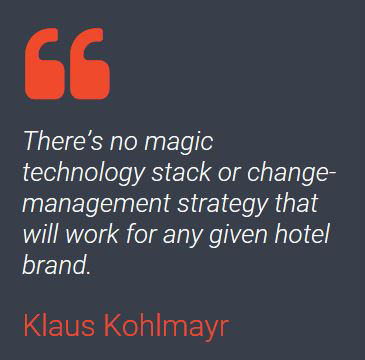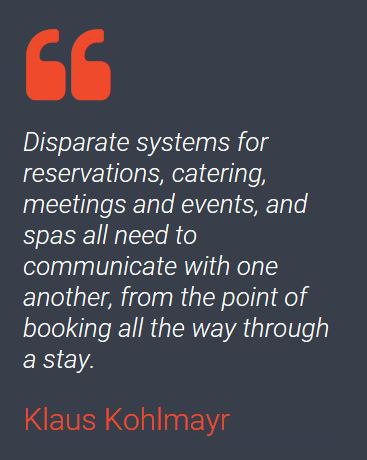
By Klaus Kohlmayr
Stop me if you’ve heard this before: In the age of OTAs and industry disruption, effectively managing a complex channel and distribution strategy is critical to a hotelier’s bottom line.
Yet archaic technology and a “this is how we’ve always done it” mindset are holding us back.
Oh, you’ve heard it? Me too. For years, actually. So why are we still here? And more importantly, what are we doing to change? Because it feels like we’re stuck in the same old rut.
A few hoteliers seem to have figured it out. They’ve realized that an integrated distribution strategy, along with its intertwined relationship to sales, loyalty and revenue management programs, represents the way forward.
These front-runners are breaking down silos and embracing modern technology stacks so they can be in front of potential guests at the moment of decision—with the right room, the right price or the perfect engagement strategy.
It may sound like lip service to talk about how technology is reshaping our space. But a few brave hoteliers are not just talking the talk.
In fact, I’ve discovered three very real (and achievable) ways these brands have successfully broken down internal silos to maximize their data insights, enhance the guest experience and improve business performance.
Give consumers the information they want, in the shape, place and format they want it
Internet-savvy guests follow the path of least resistance to research, plan and book travel. Often, they use web search tools, social media channels and OTA websites to compare and help in decision making.
The challenge for hotels is making hotel information and pricing easy to find, highly personal and relevant for guests. In an ideal world, this information is even customized based on existing or newly collected data you have for each individual guest.
In a fractured booking environment, the successful hotels create unique customer booking paths on every channel. They build customer journeys that are easy to follow and provide all the information a guest needs to easily and quickly book.
Especially in the independent and boutique world, where companies are not constrained by legacy technology, the application of highly personalized, experience-led booking capabilities are making significant inroads.
Of course, this is easier said than done, and hotels must aggregate multiple data sources including consumer insight data, Google Analytics, customer research and more in order to be successful.
Put another way, the more you understand about behavior, the more you can customize the journey for individual channels and customer segments.
Engage throughout the experience by freeing data from disparate systems
Another strategy I’ve noticed successful hotels using is guest engagement opportunities once a reservation has been made.
It doesn’t matter what channel the guest used to book; the next step in their journey should be a positive brand experience to reinforce their decision to trust your brand.
Yes, the basic approach is usually a traditional upsell offer, but can’t we do better?
Brands focused on building greater loyalty don’t ask their guest to immediately invest more—they give back in a way that is authentic.
To serve up loyalty-building guest engagement opportunities, hotels need to understand what the guest (or segment of guest) wants and what the hotel can offer that will benefit both the guest experience and hotel performance.

For example, Jenny books a multi-day weekday stay at a resort property suite for two adults and two children.
You can see that the spa and kids’ club are not well booked those days. By offering Jenny two free day passes to the kids’ club if she books a couples massage, you can incrementally improve overall revenue.
The hotel gets a new spa booking and Jenny gets a brand-boosting guest experience which improves her perception of the hotel.
For this to work (without becoming a time-consuming and manual headache), hotels must reduce their silos of technology.
Visibility across departments and systems and automation of recommendations based on guest data can create this much-needed level of engagement—but only when hotels can access all the critical data.
When in place, this creates a competitive advantage no OTA will be able to touch.
Empower the digital generation
Embracing modern hotel management technology requires a change in mindset.
The young talent coming into our business are digital natives—they grew up with iPhones, tablets, Siri and Google Assistant. Yet they’re being asked to work with sales and booking systems that are often decades old.
Forward-looking and smart hotel management teams have chosen to leapfrog over the most common middle step—trying to integrate and upgrade old systems to create a workable approach to data visibility and connectivity.
Here’s a tip: don’t bother with that middle step.
Overhauling systems can be painful, yes. But if you want to compete, now is the time to make your move. Not only do your employees expect to have fully integrated, easy-to-use and intuitive systems, your guests demand it.
Without seamless booking, accurate and competitive pricing, and personalized guest experiences, millennials and Gen Z—who together, now make up more than 50 percent of the world’s total population—will shift their loyalties to alternative lodging and rentals, most of which cater to these digital natives.

This isn’t just the technology platforms working; it’s an entirely new way to think about Hilton’s brand value to guests.
Technologies to look at include an updated cloud-based CRM system, guest interaction tools such as chat and SMS, event/meeting space, sales and marketing platforms.
The heart of the system should be a modern, automated revenue management solution that takes the guesswork out of pricing decisions and reduces the amount of work to manage your guest engagement and channel strategy.
All these platforms should have an effortless integration that allows individual systems and managers to tap into a centralized repository for guest data.
There’s no magic technology stack or change-management strategy that will work for any given hotel brand.
So, relying on the wisdom, successes and failures of those organization and technology experts who are paving the way is key.
But don’t wait—there’s a path forward that leads to a better guest experience and improved business performance if you’re brave enough to follow it.

